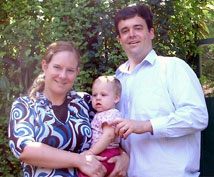NRAO eNews
November 2008 • Vol. 1, Iss. 6
- Upcoming Events
- ALMA Construction
- EVLA Prototype Correlator Tests: Impact on Observers
- Career Opportunities
- Future of U.S. Radio Astronomy Committee Report Released
 NRAO Lab Notebook: Phased Array Feed Research
NRAO Lab Notebook: Phased Array Feed Research- 20th International Symposium on Space THz Technology
- 2009 National Radio Science Meeting
- AUI/NRAO Announce 2008 Image Contest Prizes
- New ALMA Public Website Debuts
- Past Issues
- Contact the Editor
- Subscribe
- More Information
NRAO eNews: November 2008 • Volume 1, Issue 6

First prize winner of the 2008 AUI/NRAO Image Contest. A radio-submillimeter-infrared composite of the Milky Way's complex and fascinating central region. The image shows the relationships among hot, massive star formation, supernova remnants, cold molecular gas, and magnetic fields in the region near our Galaxy's central black hole.
Upcoming Events
 The EVLA Vision: Galaxies through Cosmic Time
The EVLA Vision: Galaxies through Cosmic Time
December 16-18, 2008
Socorro, NM
 National Radio Science Meeting
National Radio Science Meeting
January 5-8, 2009
Boulder, CO
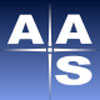 NRAO Town Hall & Reception
NRAO Town Hall & Reception
American Astronomical Society meeting
January 7, 2009 | 5:30 – 7:00 p.m. PST
Long Beach, CA |
Hyatt Seaview Ballroom
 NRAO Summer Student Research Assistantships
NRAO Summer Student Research Assistantships
Application Deadline is January 26, 2009
 NRAO Proposal Deadline (GBT, VLA, VLBA)
NRAO Proposal Deadline (GBT, VLA, VLBA)
February 2, 2009 | 5:00 p.m. ET
 20th International Symposium on Space THz Technology
20th International Symposium on Space THz Technology
April 20-22, 2009
Charlottesville, VA
ALMA Construction
Al Wootten
Operations Support Facility (OSF)
Seven Vertex antennas and four Mitsubishi Electric Company (Melco) antennas are now on the ALMA site in northern Chile. Six of these 11 antennas are visible in the panorama above (left center). Five antennas are in various stages of construction in the Vertex Site Erection Facility (SEF, left center); two Vertex antennas are being tested just outside the building. The four Melco antennas can be seen in front of the Vertex complex. The large flat area in the left foreground is being prepared for the first AEM antennas that will soon arrive from Europe.
The Operation Support Facility (OSF) Technical Building complex (right) is being readied for the arrival of the first production antennas. An ALMA transporter will move antennas to the OSF Technical Building courtyard (center right). It is expected that Melco antenna No 2 will be the first antenna moved to the OSF Technical Building complex. The two ALMA transporters can be seen in their shelter (above center right).
At the Array Operations Site (AOS) at 5000m, concrete has been poured for 27 antenna foundations. In the (AOS) Technical Building, the first quadrant of the 64-station correlator and the Atacama Compact Array 16-station correlator have been installed.
An ALMA Production Antenna is Outfited
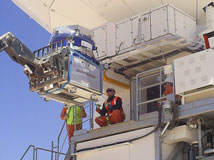
Figure 2. The first ALMA production Front End is guided into the receiver cabin on Melco antenna No 2.
The first ALMA Front End was inserted into the receiver cabin on Antenna No 2 from Mitsubishi Electric Company (Melco) on October 13. Although the antenna is not yet fully accepted by ALMA, it now contains a substantially complete set of production ALMA electronics. The Front End is dominated by the massive dewar (blue). At its base are the warm electronic assemblies that provide and convey signals to and from the receiver cartridges. The receiver cartridges are inserted in the dewar, where they are cooled to 4 K. Four preproduction cartridges have been installed in the first Front Ends, to cover the ALMA bands at 3mm (Band 3), 1.3mm (Band 6), 0.85mm (Band 7) and 0.45mm (Band 9). Receivers whose design was based on the ALMA preproduction cartridges have been successfully deployed at many millimeter observatories, including the Arizona Radio Observatory (ARO) and the Combined Array for Research in Millimeter-wave Astronomy (CARMA) in the U. S. The first Front End was assembled and tested at the North American Front End Integration Center at the NRAO Technology Center in Charlottesville.
As reported earlier, other elements in the interface between the Front End and the electronics associated with the correlator and reference signals were installed and tested already, such as the part of the Back End built at the Pete V. Domenici Science Operations Center in Socorro, NM. Elements of the Back End and of the Front End were, of course, fabricated in many labs participating in ALMA.
A number of tests and reviews are being conducted for the Melco antenna as part of the acceptance process. This process is expected to result in antenna acceptance by the end of the year. Similar tests and reviews are occurring concurrently on the Vertex antennas, which should be accepted early in 2009. Components of the AEM antennas are expected to arrive at the Operations Support Facility near year-end.
Joint ALMA Office, Santiago
Technical staff involved in ALMA construction and operations generally live in Santiago and travel to the Operations Support Facility in northern Chile for about a week, followed by time off and work in Santiago, before repeating the cycle. One new arrival in Santiago is Stuartt Corder, who began work on the commissioning team on 1 October along with colleagues Antonio Hales, who had a postdoctoral position in Charlottesville, and Tsuyoshi Sawada, from NAOJ.
Corder moved from Cal Tech with his wife Jennifer and baby daughter, Vivian. Santiago AUI/NRAO staff, led by Eduardo Hardy, worked with Charlottesville-based staff to ensure a smooth transition. Happily, Stuartt reports that the move went well, and that he had found time to resubmit one paper, now in press, and begin work on another. The family has appreciated the abundance of playground-equipped parks, one with a small aviary. They will move into longer-term quarters in a few weeks, one with ‘a wonderful view of the Andes from our patio.’ The contrast in housing affordability with Los Angeles is considerable. Spanish lessons have begun, and the family has begun to discover various interest groups. Vivian decided to begin her own discovery phase, taking her first steps just recently.
EVLA Prototype Correlator Tests: Impact on Observers
Michael Rupen and Gustaaf van Moorsel
The 4-station WIDAR prototype correlator is undergoing extensive testing at the Very Large Array (VLA), leading up to the WIDAR Critical Design Review on 2-3 December 2008. While many of these tests may be carried out during software or maintenance time, some will encroach on dynamically scheduled observations, leading to the loss of 4 antennas. Observers whose science would be severely compromised by this loss should put a note in their OBSERVE files (under Special Instructions), asking that their observations not be scheduled during 4-station WIDAR tests. As with other restrictions on dynamical files, such a request will eliminate some observing time that might otherwise be suitable, making it less likely that those observations will be dynamically scheduled. Currently we are avoiding WIDAR observations during fixed-scheduled observations and observations already involving more than one subarray, such as observations during single-dish VLBI runs. We hope to complete the critical WIDAR tests by the end of November.
Career Opportunities
The National Radio Astronomy Observatory (NRAO) has an opening for a tenure track astronomer position. The highest priority of the Observatory is to recruit new scientific staff that will enhance the scientific use and development of our new flagship facilities ALMA and EVLA. This year's search will focus on the scientific areas of astro-chemistry, proto-planetary disks, exo-planets, large-scale structure and time-domain astronomy, with technical expertise in millimeter and sub-millimeter spectroscopy, interferometric data analysis (including pipelines, data mining, high performance computing and algorithms). Preference will be given to applicants in these areas, although exceptional candidates with expertise in other areas will also be considered.
The NRAO currently operates the Very Long Baseline Array (VLBA), the 100-m Robert C. Byrd Green Bank Telescope (GBT), and the Very Large Array. It is also the North American lead in the construction of the Atacama Large Millimeter/submillimeter Array (ALMA), and is building the Expanded Very Large Array (EVLA). The completion of the EVLA and ALMA early in the next decade represents a one to two order of magnitude improvement in observational capabilities at centimeter through submillimeter wavelengths. Both facilities will be revolutionary in addressing a broad range of fundamental problems in astrophysics. Looking farther beyond, NRAO is increasingly involved in the planning of the next generation cm/m-wave facilities in the Square Kilometer Array (SKA) program.
The NRAO web site provides a description of the application process and other relevant details: http://www.nrao.edu/admin/do/tenuretrack.shtml
The deadline for applications and letters of recommendation is Monday, December 22, 2008.
The NRAO is an Equal Employment Opportunity Employer - women and minorities are encouraged to apply.
ALMA Postdoctoral Fellow: The North Radio Astronomy Observatory has an opening for a Postdoctoral Fellow to assist the ALMA Commissioning Team planning and executing the scientific commissioning of ALMA. As a member of the commissioning team, the successful applicant will work on preparing specific test procedures and trouble-shooting them, carrying out measurements, processing data and producing reports.
Software Engineer (KFPA): The K-band Focal Plane Array Project at the Robert C. Byrd Green Bank Telescope (GBT) is seeking a Software Engineer to develop monitor and control software. The seven beam array under development will improve mapping speed and map calibration for extended molecular regions. Upon completion and commissioning of the seven beam array, work will commence on a larger array and complementary hardware infrastructure.
Software Engineer: The Software Development Division at the Robert C. Byrd Green Bank Telescope (GBT) is seeking a Software Engineer to join an exciting and diverse team, with responsibilities including continuing maintenance and enhancements of the current code base and future instrumentation development, e.g. the next generation of bolometer arrays for the GBT.
Deputy Assistant Director, Green Bank Operations (Scientist/A): The National Radio Astronomy Observatory is beginning a program to develop focal plane arrays for the Green Bank Telescope. We are looking for an energetic individual to be the deputy to the Green Bank site director and to provide scientific leadership for the focal plane array development program, particularly for the GBT’s high frequency range.
Assistant Scientist (CASA Scientific Software Developer): The National Radio Astronomy Observatory (NRAO) invites applications for a software engineer, computer scientist, astronomer, or physicist with experience in astronomical data processing to develop software for the Common Astronomy Software Applications (CASA) package.
The position is an NRAO Scientist position, with 25% of time available to pursue self-directed research.
Software Engineer: The National Radio Astronomy Observatory is seeking a skilled developer to participate in the development, maintenance and support to users of the ALMA Common Software (ACS) package. ACS is located between the ALMA application software and other basic commercial or shared software on top of the operating systems and provides a generalized common interface between applications and the hardware in order to facilitate the implementation and integration into the system of new software and hardware components.
CASA Group Supervisor: The CASA Computing Division of the National Radio Astronomy Observatory is seeking a group supervisor to lead the CASA (Common Astronomy Software Applications) software group. The person filling this position will be directly involved in high-level design decisions for CASA, and will participate actively in the implementation of the resultant designs.
Engineer II: The ALMA project at the National Radio Astronomy Observatory invites applications for an Engineer II to evaluate and test overall antenna system performance. The position will be responsible for providing mechanical systems engineering support to all phases of advanced radio telescope antenna assembly, integration and final acceptance testing.
System Engineers: ALMA is seeking two System Engineers to join the team in Chile in support of the construction, commissioning and operational phases of the project. The positions involve duties in ALMA partner regions, Europe, East Asia, and North America, in the form of frequent missions to contribute to the production and integration activities of the ALMA sub-systems.
Lead Systems Engineer: ALMA is seeking a senior System Engineer for the ALMA Project to provide leadership in the definition and execution of SE activities across the project, and to manage the team in Chile in support of the construction, commissioning and operational phases of the project. The position includes responsibilities in ALMA partner regions, Europe, East Asia, and North America, requiring frequent missions to coordinate SE activities related to the production, integration and test of ALMA sub-systems.
Head of GBT Science Operations: The National Radio Astronomy Observatory is looking for an energetic individual to be responsible for the smooth and effective operation of the Green Bank Telescope from a scientific perspective. The head of science operations will lead a small group of (matrixed-managed) scientists and engineers to ensure the scientific output of the GBT remains high.
NAASC Scientist - CASA Scientific Software Developer: The North American ALMA Science Center (the NAASC) has an opening for a scientist to work on the development of the new ALMA data reduction and analysis package CASA (Common Astronomy Software Applications).
NAASC Scientist - Commissioning Liaison: The North American ALMA Science Center (the NAASC) has an opening for a scientist to work, during commissioning and verification, as a liaison between the NAASC, which is headquartered at the NRAO headquarters in Charlottesville, VA and the ALMA telescope at its high site in northern Chile.
NAASC Postdoctoral Fellow - Splatalogue: The North American ALMA Science Center (NAASC) located at NRAO headquarters in Charlottesville, VA (on the campus of the University of Virginia) invites applications for a postdoctoral fellow to work with the NAASC scientific staff as it gears up to support the needs of the community when ALMA early science begins in 2011. This position is aimed primarily at independent research, but with an emphasis on exercising ALMA end-to-end software and databases from a scientific perspective.
NAASC Postdoctoral Fellow - CASA: The North American ALMA Science Center (NAASC) located at NRAO headquarters in Charlottesville, VA (on the campus of the University of Virginia) invites applications for a postdoctoral fellow to work with the NAASC scientific staff as it gears up to support the needs of the community when ALMA early science begins in 2011. This position is aimed primarily at independent research, but with an emphasis on exercising ALMA end-user software from a scientific perspective.
ALMA Commissioning Scientists: The Joint ALMA office is seeking commissioning scientists to assist the Project Scientist and Deputy Project Scientist in planning and executing the scientific commissioning of ALMA. The successful applicants will be expected and encouraged to continue an active program of independent research.
Future of U.S. Radio Astronomy Committee
Report Released
Ethan Schreier, Associated Universities, Inc.
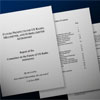 In 2007, Associated Universities, Inc. (AUI) convened a Committee on the Future of U.S. Radio Astronomy, chaired by Professor Dick McCray, of the University of Colorado. The goal of the committee was to consider the likely scientific directions for astronomy and astrophysics in the next decade and, more specifically, the place of radio astronomy in helping answer the key science questions. The McCray Committee was not asked to set priorities for current or proposed radio-millimeter-submillimeter astronomy facilities, but rather to consider the observing capabilities and technologies in these disciplines that were likely to be important in answering the science questions. AUI believed that the results of such a Committee would be useful input to the next Decadal Survey, which would not only consider all astronomy sub-disciplines, but would also receive reports about specific facilities and technology development proposed for the future.
In 2007, Associated Universities, Inc. (AUI) convened a Committee on the Future of U.S. Radio Astronomy, chaired by Professor Dick McCray, of the University of Colorado. The goal of the committee was to consider the likely scientific directions for astronomy and astrophysics in the next decade and, more specifically, the place of radio astronomy in helping answer the key science questions. The McCray Committee was not asked to set priorities for current or proposed radio-millimeter-submillimeter astronomy facilities, but rather to consider the observing capabilities and technologies in these disciplines that were likely to be important in answering the science questions. AUI believed that the results of such a Committee would be useful input to the next Decadal Survey, which would not only consider all astronomy sub-disciplines, but would also receive reports about specific facilities and technology development proposed for the future.
The Committee had several open meetings, solicited inputs from the community, held town hall meetings, posted material on the AUI website, requested formal reviews on a first draft from some 25 senior astronomers, and iterated its report over many months.
The final report was received by AUI, and the release of the Report was authorized by the AUI Board at its October meeting in Santiago, Chile. The report is now available for downloading, and will be transmitted to the Astronomy and Astrophysics 2010 Decadal Survey.
AUI wishes to thank the Committee, its Chair, and all the members of the astronomy community who participated in this endeavor.
NRAO Lab Notebook: Phased Array Feed Research
Roger Norrod and Rick Fisher

Development work on phased array feeds shifted into high gear a couple of years ago, most notably in Australia, the Netherlands, Canada, and the United States. Phased array feeds (PAFs) promise to make much greater use of the information falling on the focal plane of a radio telescope than occurs with horn feeds or arrays. However, the close-packed nature of PAFs presents some serious challenges to antenna and receiver designers, mainly due to mutual coupling between array elements and the open-field electromagnetic configuration. NRAO involvement in this work is a close collaboration with Drs. Brian Jeffs and Karl Warnick and their students at Brigham Young University (BYU). Our group is concentrating on the RFI cancellation, low-noise matching, and cryogenic aspects of PAFs while other groups are leading wideband array research.
A PAF workshop in Holland sponsored by ASTRON in November 2007 was a milestone in international collaboration that resulted in a new understanding of mutual coupling and has led to a common definition of efficiencies that work for mutually coupled arrays. The most difficult questions were how to define the receiver noise temperature for a beam formed by a PAF and how to impedance-match amplifiers to the array to minimize noise. Karl Warnick was a major contributor to the workshop.
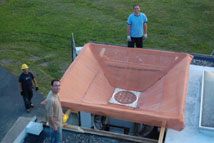
Figure 1: The phased array receiver and ground screen mounted in the Green Bank Indoor/Outdoor test facility. Clockwise from top are BYU students Jacob Waldron, Jonathan Landon, and Jiyoung Son.
In the January 2008 NRAO Newsletter we reported first beam-forming and interference mitigation results from the BYU/NRAO 19-element, 20-cm wavelength array installed on the Green Bank 20-meter antenna. In June 2008, BYU engineering students Jonathan Landon, Jacob Waldron, and Jiyoung Son worked hard at revitalizing the array receiver. They installed new, 30 K noise temperature first amplifiers to replace the old 100 K units. Their first objective was to understand the receiver noise before it went on the telescope. Measurements at the coaxial LNA input ports were relatively straightforward, but array measurements needed to include the dipole elements and reverse amplifier noise coupled to other array elements. This called for a “sky noise” Y-factor measurement, using the sky as a cold load and a large ambient absorber as a hot load. To suppress weak but significant pickup of ground radiation from array back and side lobes, a ground screen was necessary. The BYU team, with some help from Green Bank staff, built a large inverted pyramidal frame covered with copper screen to fit around the array. Figure 1 shows the ground screen and array receiver just before the first night’s noise measurements.
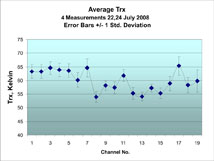
Figure 2: Receiver sky noise test results at 1612 MHz. Channel 1 is the array center element, channels 2-7 are the first ring, and channels 8-19 are the second ring of dipole elements.
Jonathan returned to Green Bank in July 2008 with fellow student Mike Elmer. Together with Roger Norrod and Bob Simon, they spent a week doing more array sky noise measurements before mounting the system on the 20-meter. Figure 2 shows the average results from four sky noise tests. Note that the center elements show higher noise relative to the outer elements, as expected due to mutual coupling between elements. The noise distribution in the array receiver on the telescope is roughly: 33 K LNA, 16 K mutual coupling, 7 K spillover, 7 K sky, 5 K ohmic loss. These values agree well with those predicted from known dipole impedances, coupling coefficients, and measured amplifier noise and impedance parameters. More importantly, we see how to improve on the mutual coupling noise with better impedance match of the dipoles to the amplifiers.
The proof in the pudding, of course, is to show that the array can make accurate, low-noise maps of the sky on the telescope and do so in the presence of interference. As the receiver went on the 20-meter, Brian and Karl arrived for eight days of observing. Using new telescope control software tailored to array tasks, the group calibrated the array by observing a strong radio source in a grid of positions in the field of view and computing beam-forming coefficients that optimized the source to system noise ratio at each point. The ratios agreed very well with sky noise measurements from the previous week and showed that the aperture efficiency of the array-telescope combination was ~ 70%, considerably better than is typically achieved with a prime focus horn feed. As far as we know, this is the best system noise to aperture efficiency ratio obtained with a PAF.

Figure 3. (left) A mosaic of maps of the Cygnus X region made with the PAF on the 20-meter telescope. Compare this to a composite map (right) of the same region from the Canadian Galactic Plane Survey smoothed to the resolution of the 20-meter (white circle on left image).
After the array was calibrated it was used to map the complex radio continuum field in the outer part of our own Galaxy, the Cygnus X region. Figure 3 shows a mosaic of array feed field maps compared with a 1420-MHz continuum composite map of the same region of sky from the Canadian Galactic Plane Survey, smoothed to the 20-meter telescope resolution. The 20-meter map would have taken 25 times as long to make with a single beam with the same system temperature.
In addition to forming multiple beams, the PAF can excise RFI by spatial filtering of the received signal. Additional 20m maps were made in the presence of strong RFI and results will be reported in a future eNews.
Understanding the noise, efficiency, calibration, and RFI mitigation properties of an uncooled array is a key step toward a PAF whose individual beams have noise temperatures similar to the best single-beam receivers. This is our ultimate goal, which requires that we do the engineering research that would allow us to cool the amplifiers and probably the array elements to cryogenic temperatures. Many of the techniques used in conventional cooled receivers, such as massive coldstraps and conventional vacuum windows, will not work in open-structure arrays. There are interesting challenges ahead.
Acknowledgments
The BYU Radio Astronomy Laboratory research into phased array feeds is partially supported by ATI and MRI grants from the National Science Foundation.
For assistance with this summer’s experiments, thanks go to the Green Bank Electronics, Telescope Operations, and Plant Maintenance staffs. Special thanks to Pete Chestnut, Bob Goldizen, and Rusty Taylor for cheerful assistance after equipment failures, even though, as usual, the problems happened at inconvenient times.
20th International Symposium on Space THz Technology
Eric Bryerton
 NRAO is co-sponsoring the 20th International Symposium on Space THz Technology next April 20-22 in Charlottesville, Virginia at the Omni Hotel.
NRAO is co-sponsoring the 20th International Symposium on Space THz Technology next April 20-22 in Charlottesville, Virginia at the Omni Hotel.
The International Symposium on Space THz Technology is the premier forum for developers of low-noise sub-millimeter and THz receivers. The technical scope of this conference includes millimeter-wave/terahertz instruments for astrophysics and other applications; heterodyne and direct detectors such as Schottky, SIS, HEB, TES, KID, and bolometers; sources such as frequency multipliers, lasers, and other technologies; optics and measurement techniques; and THz systems and backends.
Please see the conference web site at http://www.nrao.edu/meetings/ISSTT2009/.
Abstracts are due December 12, 2008 and February 28, 2009 is the final day for early registration.
2009 National Radio Science Meeting
Al Wootten
The annual National Radio Science Meeting, sponsored by the U.S. National Committee of the International Union of Radio Science (URSI) will be held January 5-8, 2009 in Boulder, CO. Details are available at http://www.nrsmboulder.org/
Note, however, that the topics for Commission J, Radio Astronomy, are incorrectly listed on this web page. The topics and session chairs will include:
- Astronomy at Terahertz Frequencies (Blundell)
- ALMA Technology, Science and Status (Wootten)
- Wideband Astronomy Instrumentation (Bastian)
- Long Baseline Interferometry (Walker)
- New Telescopes, Techniques and Observations (Cordes)
Abstracts for the talks in these sessions
AUI/NRAO Announce 2008 Image Contest Prizes
Mark Adams and Dave Finley
Associated Universities, Inc. and the National Radio Astronomy Observatory are pleased to announce and congratulate the prize recipients of the 2008 AUI/NRAO Image Contest.
The power of multiwavelength imaging is the common theme of winners in the 2008 AUI/NRAO Image Contest. The three top prize winners and three honorable-mention winners combined, all told, data from NRAO and other radio observatories with submillimeter, optical, infrared, and X-ray data from ground-based and orbiting observatories. Twenty images were submitted by 11 scientists.
The results were both scientifically intriguing and beautiful.
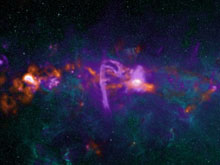 The $1,000 first prize went to Adam Ginsburg of the University of Colorado-Boulder, for a radio-submillimeter-infrared composite of the Milky Way's complex and fascinating central region. The image shows the relationships among hot, massive star formation, supernova remnants, cold molecular gas, and magnetic fields in the region near our Galaxy's central black hole.
The $1,000 first prize went to Adam Ginsburg of the University of Colorado-Boulder, for a radio-submillimeter-infrared composite of the Milky Way's complex and fascinating central region. The image shows the relationships among hot, massive star formation, supernova remnants, cold molecular gas, and magnetic fields in the region near our Galaxy's central black hole.
 The second prize winner, Francesco Massaro of the Harvard-Smithsonian Center for Astrophysics, used radio, optical, and X-ray data to produce a compelling image of the radio galaxy 3C 305 in the constellation Draco.
The second prize winner, Francesco Massaro of the Harvard-Smithsonian Center for Astrophysics, used radio, optical, and X-ray data to produce a compelling image of the radio galaxy 3C 305 in the constellation Draco.
 The third prize image combined radio and X-ray data of the remnant of the Supernova of 386 AD. Mallory Roberts of Eureka Scientific, Inc. continued the work begun by the ancient Chinese astronomers who observed the supernova explosion. The X-ray data reveals a wind created by a pulsar at the center of the remnant.
The third prize image combined radio and X-ray data of the remnant of the Supernova of 386 AD. Mallory Roberts of Eureka Scientific, Inc. continued the work begun by the ancient Chinese astronomers who observed the supernova explosion. The X-ray data reveals a wind created by a pulsar at the center of the remnant.
Three images received honorable mentions. Farhad Yusef-Zadeh of Northwestern University won for an image of stars and gas orbiting the massive black hole at the Milky Way's center. Michael Bietenholz of York University and Hartebeesthoek Radio Observatory won for a radio-X-ray image of the pulsar-powered supernova remnant G21.5-0.9, and Volker Heesen of Astronomisches Institut der Ruhr-Universität Bochum (AIRUB) won for an image revealing the magnetic-field structure in the nearby starburst galaxy NGC 253.
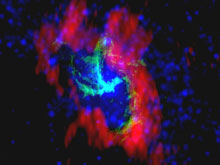
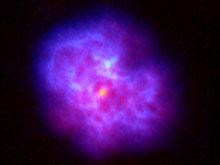
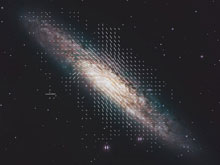
"Our congratulations go to all the winners, along with our appreciation for their efforts at making beautiful images that provide unique scientific insights," said NRAO Director Fred K.Y. Lo. "We also want to thank the Prize Panel who volunteered their time: Zolt Levay of the Space Telescope Science Institute; and Aeree Chung, Ron Maddalena, and John Stoke of the NRAO."
New ALMA Public Website Debuts
William Garnier, Joint ALMA Observatory
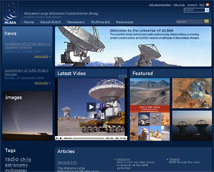
After months of effort, ALMA has a new website for the public, http://www.almaobservatory.org, released on October 30. This task was achieved by the Joint ALMA Observatory (JAO) EPO (Education & Public Outreach) department with the support of the Executives’ (ESO, NAOJ, and NRAO) EPO departments. The support of ALMA scientists was also instrumental in ensuring the accuracy of the scientific and technical information available on the website, both in English and Spanish.
The new site contains four main sections: “About ALMA”, “Newsroom”, “Multimedia” and “Resources.” Additionally, it contains a section on job opportunities with ALMA and gives the user the possibility of getting the latest ALMA-related news, events and multimedia material by subscribing to RSS feeds.
The “About ALMA” section covers a range of information about ALMA’s universe: the timeline, science and technology, infrastructure, geographical location, internal structure and management and a guide to the acronyms used in ALMA.
The “Newsroom” section, mainly designed for the worldwide media, is a repository of all press and web releases related to ALMA from its beginning, classified in chronological order. This section also contains a list of main scientific events in which ALMA will be represented as well as useful information for journalists planning to visit our facilities and EPO contact information in Chile and the regions.
The “Multimedia” section gives a global view of ALMA’s universe through images, 3-D animations, videos, and webcams. The images are divided into specific sections, which make the searches easy, and are downloadable in different resolutions. ALMA-related videos, produced either by the JAO EPO Department or the EPO Departments of the Executives, are visible in streaming and also downloadable.
The “Resources” section contains free downloadable publications on the project, such as the beautifully illustrated book on biology in the ALMA area, and easy-to-build paper models of the antennas and the transporter. A radio astronomy FAQ and an astronomical glossary offer a good introduction to radio astronomy and ALMA to people who are completely new to astronomy, as well as to those who have a greater acquaintance with it.
The "Internal Links," which were formerly located under "ALMA Resources" at the bottom of the www.alma.cl webpage, are now accessible from a link located in the footer of the www.almaobservatory.org domain. Since these links are for internal purposes, they are visible only inside the private networks of ALMA and the Executives.
The architecture of the website was designed by professionals, following the requirements specified by the ALMA-related EPO departments. Designed to be user-friendly and easy to navigate, the website also possesses a flexible content management system. Last but not least, the website aims to be dynamic and constantly updated with new tools, articles, resources, pictures, videos, etc. This will be one of the priorities of the JAO EPO department.

 Zoom
Zoom